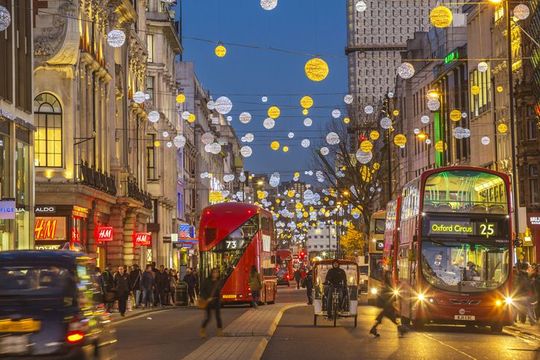
London at Christmas Getty: Images
5 of the best… festive traditions.
Who doesn’t love the festive period? It’s a time for families to come together and share gifts, time and stories with each other. A time to acknowledge the year gone by and welcome the incoming year and all that it may hold. British culture is steeped in a rich and varied history and celebrations around this time are no different. All corners of Britain have their own traditions and here are some of our favorites.
Read more
The King’s Speech
Every year, British people sit down at 3 pm on Christmas Day to watch the Queen or King deliver their Christmas speech. The speech has been a royal tradition since King George V delivered the first Christmas message in 1932. Queen Elizabeth II delivered the first televised Christmas speech in 1957. That year, the speech was delivered from the Long Library in Sandringham House and the Queen spoke to her subjects about the importance of truth and honesty. The Queen’s speech in 2019 was delivered from the Green Drawing Room in Windsor Castle and Her Majesty mentioned the birth of her great-grandson Archie Mountbatten Windsor and how new generations hold such a pivotal role in issues pertaining to climate and protecting the environment.
Hogmanay
The world-famous Scottish Hogmanay dates back to the Vikings and marks the arrival of the New Year. Perhaps the most famous Hogmanay celebration is held in Edinburgh over three days. The festivities kick off on December 30th when thousands of revelers light up the streets of Edinburgh with flaming torches and play pipes and drums to mark the beginning of the festival. December 31st sees the Hogmanay Street Party on Edinburgh’s Princes Street where live music and dancing takes place against the dramatic backdrop of Edinburgh Castle. The night draws to a close and the New Year is welcomed by a spectacular firework display and party-goers draw the night to a close while singing Auld Lang Syne, in what is said to be the biggest rendition of the song in the world.
Christmas dinner
Food is a pivotal part of the Christmas celebrations in Britain, with a traditional roast normally served for Christmas Day dinner. Roast turkey is usually the meat of choice and cooking and carving the bird is taken very seriously. With a medley of accompaniments, the Christmas dinner plate is laden with roast potatoes, carrots, stuffing, Yorkshire pudding and the all-important gravy. Some choose to add the controversial Brussels sprouts, but love them or hate them they are as Christmassy as Father Christmas himself. Dessert is also a central focus for the British Christmas dinner and the traditional Christmas trifle is usually first and foremost on most people’s list. A simple layering of sponge, sherry, custard, whipped cream and fruit are the essential ingredients of this much-loved dessert.
Pantomimes
Embedded in British culture, the pantomime or panto is considered a main focus point of the festive season by many families. The characters are usually larger than life with men dressed as women for added comedic effect. Laden with jokes for children and subtle innuendos for adults, panto is a guaranteed laugh in the build-up to Christmas. Audience participation is a key element and the sound of voices shouting “he’s behind you” and “oh no he isn’t” are only part of the fun. The story is usually based around much-loved children’s classics such as Aladdin or Cinderella and in bigger productions British celebrities often take on the starring role. A real must-do in Britain at Christmas.
Y Nadolig
Traditionally Welsh houses were decorated with holly and mistletoe, with the fresh holly symbolizing eternal life and the mistletoe warding off evil. The Christmas custom in Wales involved an early morning church service, usually attended only by men, where carols were sung in harmony from 3 am to 6 am. Once the service was over, the Welsh enjoyed a day of celebrations and drinking. Boxing Day in Wales was celebrated in a particularly unique way until the end of the 19th Century. Men and boys were involved in a practice known as holly-beating, where young women were beaten with holly branches until they bled.





Comments